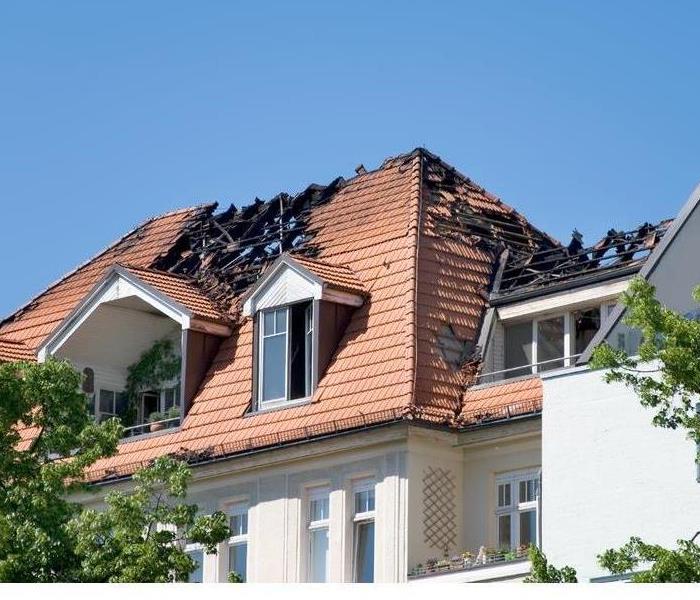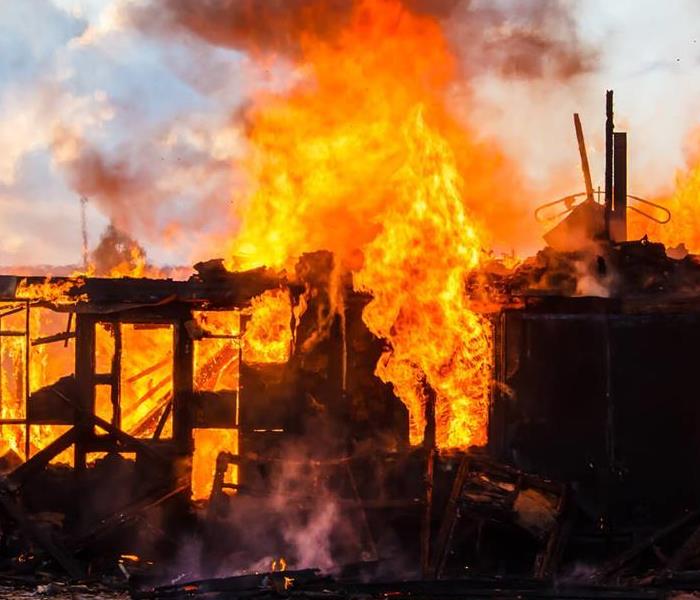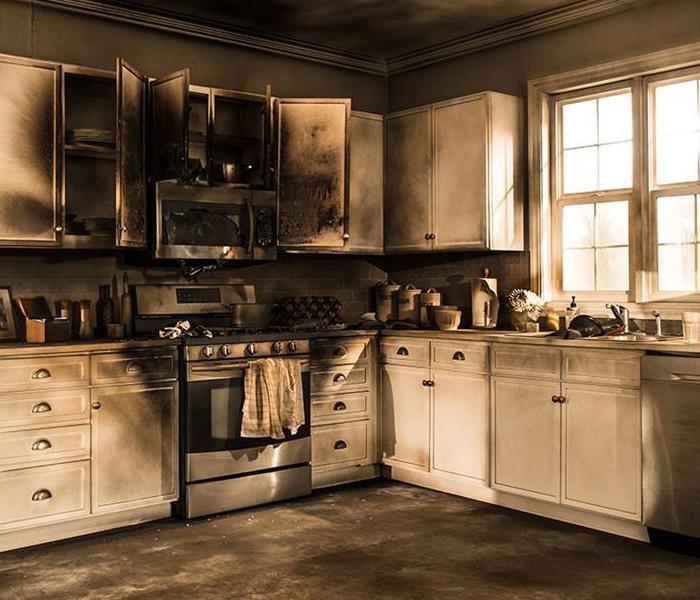Recent Fire Damage Posts
Electrical Safety
9/29/2023 (Permalink)
Consumer electronic products are more prevalent than ever. Research indicates that the average household owns more than twenty-five consumer electronic products. With all of today's technology, it can prove challenging to safely maintain power to all of our electronic devices. Electrical outlets are easy to overload and as a result, may become hazardous. While adding a power strip or extension cord seems like an easy solution to a lack of electrical outlets, the wiring in some buildings often isn't capable of supporting too many high-powered electronic appliances.
Older office buildings and homes, in particular, often suffer from lack of electrical outlets. The temptation is to simply add a power strip or plug in an extension cord from across the room. Even in newer office buildings and homes, it can be all too easy to overload a single outlet with power hungry machines such as computers, printers, scanners, and monitors.
When an employee or resident overloads an electrical outlet, that means more current is running through the outlet than it can handle. This causes the outlet to overheat, which may lead to an electrical fire. According to a 2008 National Fire Protection Association study, electrical distribution and lighting equipment are involved in more than 24,000 home structure fires per year. These fires resulted in an average of 320 deaths per year and an estimated $700 million in property damage per year.
If an electrical fire should occur, get safely away from the fire and call your fire department. If you choose to use an extinguisher on the fire, never let the fire get between you and a safe exit, and never let use water to extinguish an electrical fire. Class C fire extinguishers use a non-conductive extinguishing agent and should not cause electrical shock.
To help prevent this and other electrical hazards, refer to the list below (provided by Electrical Safety Foundation International).
- If you must use a power strip, use a name brand product from a reputable retailer. Low-quality or counterfeit power strips may contain wiring that isn't adequate to carry the load.
- Place power strips where there is plenty of air circulation to disperse the heat.
- Never attempt to plug grounded (three-pronged) cords into an ungrounded (two-pronged) outlet.
- Do not blind, kink or know electrical cords.
Can You Repair a Fire-Damaged House?
9/29/2022 (Permalink)
 Fire damage to the roof of a home. The fire burned a large hole in the roof.
Fire damage to the roof of a home. The fire burned a large hole in the roof.
If your home has been harmed by smoke or fire, you are likely wondering if fire damage restoration is viable. It is in fact possible to return your home to pre-damage conditions. The key is to find the right restoration and cleaning service. If you live in Saunders County, NE, keep reading to find out how the effects of a fire can be reversed.
Repairing Your Home or Business After a Fire
Fire can have a devastating impact on any structure. The intense heat, smoke, and subsequent water damage caused by emergency crews and sprinkler systems can be highly destructive. However, unless a structure has been burned beyond repair, there is usually a way to clean and revive damaged surfaces so that they can be fully restored to their original condition.
The Fire Damage Restoration Process
The sooner your restoration crew gets to the site of the fire, the better. Responding right away with the appropriate resources and equipment will help to ensure that no further damage occurs. Your restoration technicians will immediately board up any windows that have been damaged and add a tarp to the roof if your roofing has been compromised. This will protect your home from further damage until these structures can be repaired.
After a thorough inspection of the fire, smoke, and water damage, the process of removing black soot and drying out damp surfaces begins. It is important to initiate the drying and disinfecting process as soon as possible before mold begins to form. The right tools used by a qualified restoration professional can ensure that affected surfaces are restored before any permanent damage sets in.
How Does Soot Removal Work?
Soot is a particularly difficult substance to remove from any surface and requires specialized techniques to ensure its complete removal. There are custom vacuums, sponges, and cleaning products that are specifically designed to remove this sticky substance. Using the wrong product or equipment to remove soot can actually spread it around and make the stain even worse.
What Can Be Done About Water Damage?
If industrial-grade dehumidifiers and fans are brought in right away, the drying process should be complete before any permanent damage takes place. The key is to not allow moisture to sit on surfaces (particularly wood or drywall) for a significant length of time. This can lead to warping and mold formation.
Finding a Reputable Restoration Professional in Saunders County
Restoring your home or business after a fire is not a do-it-yourself project. It requires the right equipment and expertise. A professional restoration company will not only clean, dry out, and disinfect any damaged surfaces, but it will also ensure that the right repairs take place. This may include painting, drywall, and flooring replacement, or in severe cases, a complete renovation of some rooms.
If your home or business has been damaged by fire or smoke, contact us today at SERVPRO. We will make sure that the right steps take place to return your structure to its previous condition.
Helpful tips to prevent a house fire
9/19/2022 (Permalink)
House fires kill and injure many every year, while leaving many without their home, and valuable memories and possessions. Fire prevention is more important than many realize.
Ways to Prevent House Fires
-Establish an emergency plan with fire routes.
-Test all smoke alarms in your home.
-Teach your children fire safety.
-Perform home maintenance consistently.
- Use candles with caution.
-Don't leave food cooking unattended.
- Store flammables safely.
- Know where the fire extinguishers are and how to use them.
- Check all electrical cords in your home. If wires are frayed, throw it away.
Fire preparation is an important part of safeguarding your home and your family. Knowing not only how to prevent a fire but also how to escape it and get quick fire cleanup is essential.
Top 5 Common Causes of Fire Damage
9/6/2022 (Permalink)
 Take Steps to Prevent House Fires
Take Steps to Prevent House Fires
One of the best ways of dealing with a fire is to prevent its occurrence in the first place. The best way to prevent a fire from occurring in your home is to know its likely causes. According to the National Fire Protection Agency (NFPA), the five most common causes of fires include: 1) cooking; 2) heating; 3) electrical; 4) smoking; and 5) candles. Here is what to know about each one so you can prevent a fire in your home.
Cooking
The NFPA reports that from 2015-2019, cooking caused 49 percent of reported home fires, 20 percent of reported home fire deaths, and 42 percent of home fire injuries. It is the most common cause of residential fires. Major cooking holidays such as Thanksgiving and Christmas are the riskiest time for cooking fires.
Approximately 44 percent of house fires begin in the kitchen or cooking area and from 2013-2017, almost half of all home structure fires were caused by cooking. These fires are commonly due to things being left cooking unattended as well as open flames and spills. If someone is not in the kitchen to extinguish the fire it can quickly get out of hand.
Tips
- Maintain a fire extinguisher in the kitchen (that is rated for kitchens)
- Don’t use the stove if you are tired or have consumed any alcohol
- Remain in the kitchen while cooking
- Utilize a timer to remind you that things are cooking
- Keep anything that could catch fire (e.g. paper towels, oven mitts, wooden utensils) away from the stove.
Heating
Per the NFPA, from 2014-2018, local fire departments responded to an average of about 48,530 fires annually that involved heating equipment. This is equal to about 14% of all reported home fires during this time period and resulted in approximately 500 civilian deaths and 1,350 civilian injuries each year.
The most common heating cause of fires is space heaters. Although fireplaces and furnaces can pose a risk, space heaters can cause a fire simply by being left too close to other things that can catch fire.
While furnaces can cause fires in a home, space heaters and fireplaces are more common sources of heating equipment fires.
Tips
- Always keep anything that can burn a minimum of 3 feet from heating equipment
- Each year you should have your heating equipment, such as your chimneys, cleaned and inspected by a professional
Electrical
Another common cause of fires in the home is electrical, namely faulty wiring. You may be able to tell that your house has faulty wiring if you see blinking lights, lights that dim when you turn on appliances, or sparks coming from an electrical outlet.
Tip
- Always have all electrical work done by a professional
Smoking
Another common cause of fire damage is lit cigarettes or lighters. Sadly, one out of every four victims who die from a smoking-material fire is not the smoker. Merely dropping a lit cigarette can cause a blaze that spreads throughout the entire house. This often occurs when someone drops a cigarette after falling asleep. The best way to combat fire damage from smoking is by always smoking outside of the home.
Tips
- Only smoke fire-safe cigarettes
- Always smoke outside
- Always keep smoking materials (e.g. cigarettes, lighters, etc.) out of the reach of children
- Never leave e-cigarettes to charge unattended
- Never smoke around medical oxygen, which is easily combustible
- Candles
According to the NFPA, each year (from 2015-2019) U.S. fire departments responded to approximately 7,400 home structure fires that were started by candles. These fires resulted in an average of 90 fatalities and 670 injuries per year. An average of 20 home candle fires are reported daily.
Tips
- Never leave candles burning attended
- Always trim the candle wick after each use
- Keep candles at least a foot from anything that can burn
- Always blow out candles before going to sleep or leaving the room
Fire preparation is an important part of safeguarding your home and your family
8/2/2022 (Permalink)
 Fire preparation is an important part of safeguarding your home and your family.
Fire preparation is an important part of safeguarding your home and your family.
House fires kill and injure many every year, while leaving many without their home, and valuable memories and possessions. Fire prevention is more important than many realize.
Ways to Prevent House Fires
-Establish an emergency plan with fire routes.
-Test all smoke alarms in your home.
-Teach your children fire safety.
-Perform home maintenance consistently.
- Use candles with caution.
-Don't leave food cooking unattended.
- Store flammables safely.
- Know where the fire extinguishers are and how to use them.
- Check all electrical cords in your home. If wires are frayed, throw it away.
Fire preparation is an important part of safeguarding your home and your family. Knowing not only how to prevent a fire but also how to escape it and get quick fire cleanup is essential.



 24/7 Emergency Service
24/7 Emergency Service


